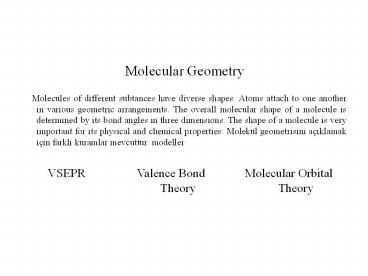Valence Shell Electron Pair Repulsion (VSEPR) Theory - PowerPoint PPT Presentation
Title:
Valence Shell Electron Pair Repulsion (VSEPR) Theory
Description:
Molecular Geometry Molecules of different subtances have diverse shapes. Atoms attach to one another in various geometric arrangements. The overall molecular shape of ... – PowerPoint PPT presentation
Number of Views:156
Avg rating:3.0/5.0
Title: Valence Shell Electron Pair Repulsion (VSEPR) Theory
1
Molecular Geometry Molecular Geometry Molecular Geometry
Molecules of different subtances have diverse shapes. Atoms attach to one another in various geometric arrangements. The overall molecular shape of a molecule is determined by its bond angles in three dimensions. The shape of a molecule is very important for its physical and chemical properties. Molekül geometrisini açiklamak için farkli kuramlar mevcuttur. modeller Molecules of different subtances have diverse shapes. Atoms attach to one another in various geometric arrangements. The overall molecular shape of a molecule is determined by its bond angles in three dimensions. The shape of a molecule is very important for its physical and chemical properties. Molekül geometrisini açiklamak için farkli kuramlar mevcuttur. modeller Molecules of different subtances have diverse shapes. Atoms attach to one another in various geometric arrangements. The overall molecular shape of a molecule is determined by its bond angles in three dimensions. The shape of a molecule is very important for its physical and chemical properties. Molekül geometrisini açiklamak için farkli kuramlar mevcuttur. modeller
VSEPR Valence Bond Theory Molecular Orbital Theory
2
Valence Shell Electron Pair Repulsion (VSEPR)
Theory
- It is a method for predicting the shape of a
molecule from the knowledge of the groups of
electrons around a central atom.
3
(No Transcript)
4
Electron pairs (bonding and nonbonding electrons)
repel one another, as a result , the electron
pairs remain as far apart as possible from
another as possible to minimize the repulsion.
- Two electron pairs in the valence orbital are
arranged linearly - Three electron pairs are organized in a trigonal
planar arrangement - Four electron pairs are organized in a
tetrahedral arrangement - Five electron pairs are arranged in a trigonal
bipyramid - Six electron pairs are organized in an
octahedral arrangement
The repulsion of lone pair electrons is grater
than the repulsion of bond pair electrons
5
Electron pairs assume orientations about an atom
to minimize repulsions.
6
Applying the VSEPR theory.
- draw a plausible Lewis structure of the molecule
or polyatomic ion. - Determine the number of unshared electron pairs
and numbers of bonds around the central atom (
multiple bonds count as a single bond) - B? No
- Establish the geometrical orientation of the
electron pairs around the central atom as linear,
trigonal planar, tetrahedral,, trigonal bipyramid
or octahedral - Describe the molecular geometry
7
question predict the shape of CO2 HCN CH4, NH3
SO2 PCl5, SF6 and H2O by using VSEPR theory.
8
question predict the shape of CO2 HCN CH4, NH3
SO2 PCl5, SF6 and H2O by using VSEPR theory.
9
- The nonbonding electron pairs are as important as
bonding electron pairs in determining the
structure. - Nonbonding electrons take up more space in the
valence shell than the bonding electrons. - If one or more of the electron pairs are lone
pairs, the distribution of electron pair and the
geometrical shape of the molecule must be
different. - The bond angles decrease as the number of
nonbonding electron pairs increases
Repulsion strengths lone pair -lone pair ?
lone pair e-bond pair ? bond pair-bond pair
10
(No Transcript)
11
(No Transcript)
12
(No Transcript)
13
(No Transcript)
14
(No Transcript)
15
(No Transcript)
16
(No Transcript)
17
(No Transcript)
18
Valence bond theory
- The covalent bonds are formed by overlap of
atomic orbitals each of which contains one
electron of opposite spin.
19
(No Transcript)
20
The valence bond method predicts molecule shapes
from the shapes and orientation of the atomic
orbitals and their overlap regions when two atoms
approach. In most cases the orbitals that
overlap are reconfigured orbitals, called hybrid
orbitals, having different shapes and
orientations than pure orbitals. The process of
hybridization corresponds to a mathematical
mixing of the valence-shell atomic orbitals.
21
(No Transcript)
22
Bonding in Methane
23
Valence Electron Pair Geometry Number of Orbitals Hybrid Orbitals
Linear 2 sp
Trigonal Planar 3 sp2
Tetrahedral 4 sp3
Trigonal Bipyramidal 5 sp3d
Octahedral 6 sp3d2
24
- question find the hybridazation type and
geometry of CH4, PCl5, SF6. NH3 BeF2
25
Multiple Covalent Bonds
26
Molecular Orbital Theory
A molecular orbital describes a region of space
in a molecule where electrons are most likely to
be found. Molecular orbitals are formed by
combining atomic orbitals on different atoms.
27
Combining Atomic Orbitals
28
(No Transcript)
29
(No Transcript)
30
(No Transcript)
31
(No Transcript)
32
(No Transcript)
33
(No Transcript)
34
(No Transcript)
35
(No Transcript)
36
(No Transcript)
37
Bonding in Metals Bonding in Metals
Electron sea model Band theory.
38
12-7 Bonding in Metals
- Electron sea model
39
Bonding in Metals
- Band theory.
40
Band Theory
41
Semiconductors
42
Photovoltaic Cells
43
(No Transcript)
44
(No Transcript)
45
(No Transcript)































